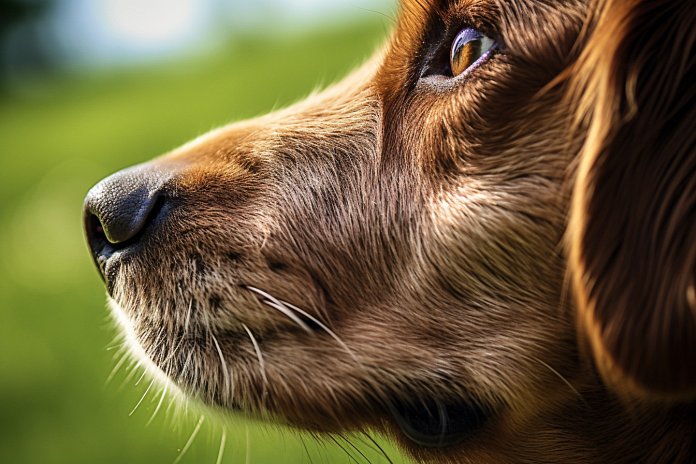
Every dog owner has experienced their dog obsessively licking their arm or leg, only to discover a cut or scrape they hadn’t noticed. How do dogs know about these wounds? It turns out, dogs have an incredible sense of smell and can detect even the smallest physiological changes in humans. They can smell wounds in parts per trillion, meaning they can detect an open wound before it is visible. Furthermore, when dogs smell a wound, they instinctively try to clean it because their saliva has antimicrobial and clotting properties that can help wounds heal faster. In this article, we will explore how dogs behave when they notice a wound, why they lick wounds, scientific studies supporting these theories, and how to train your dog to leave your wound alone.
Signs Your Dog Smells Your Cut
If your dog notices a wound on you, they will not simply ignore it. Licking wounds is an instinctual reaction for dogs because it helps clean out the wound and prevent infection. If your dog pays a lot of attention to a specific body part or won’t keep their nose away from you, it is likely they have detected a wound. Obsessive licking is another sign that your dog has found a cut and is trying to clean it. Pay attention to these signs if you suspect your dog has sniffed out a wound on you.
Body Language
Some signs that your dog has found a wound include being alert, guarding the area, sniffing, lip licking, tongue flicking, nose licking, licking the wound, and hanging their tongue. Other signs may include anxious behavior, nosing your body, guarding and alertness, obsessive licking, and pawing at you or your body.
History of Dogs Smelling Our Cuts
Dogs sniffing and licking wounds is an instinctual and learned behavior that begins at birth. When puppies are born, their mother licks them to protect them from infections caused by bacteria like E. Coli and S. Canis. Canine saliva has been found to kill these bacteria, so the licking serves a protective purpose. This behavior continues into adulthood, as dogs consider their human owners part of their pack and have a natural instinct to care for and protect them from infections.
Science Behind Your Dog Smelling Your Cut
Dogs have a pack mentality, even when domesticated. They see their human owners as part of their pack and have a natural desire to care for and heal them. This pack mentality drives dogs to sniff out wounds and lick them, as it is a way of keeping their pack healthy. Dogs instinctively know that keeping their owners healthy benefits the entire pack, as the owner provides food and protection.
Training Your Dog to Leave Your Cuts Alone
If you don’t want your dog to obsessively lick and sniff your wounds (which can lead to infection in humans), it is important to train them to follow basic commands such as “no,” “leave it,” and “stop.” These commands can help redirect their attention away from your wounds. Crate training can also be helpful in teaching your dog to give you space while you clean and heal your wounds. By providing a comfortable and safe crate, you can create a designated space for your dog to wait until you are finished.
In conclusion, dogs have an exceptional sense of smell that allows them to detect even the smallest wounds on humans. Their instinct to lick and clean wounds is rooted in their pack mentality and desire to keep their owners healthy. While it can be challenging to train them to leave your wounds alone, using basic commands and crate training can help redirect their behavior. Remember, your dog is only trying to help, so be patient and appreciate their efforts in keeping you healthy.
“The healing power of a dog’s love: How your furry friend can sniff out and help heal your wounds”

Tips & Things to Know
1️⃣ Dogs have an incredible sense of smell and can detect even the smallest physiological changes in humans. They can smell wounds before you even see them, so pay attention if your dog starts sniffing or licking a certain area of your body.
2️⃣ When dogs lick wounds, they are instinctively trying to clean them and prevent infection. Their saliva has antimicrobial and clotting properties. However, it’s important to train your dog to leave your cuts alone to avoid potential infections in humans.
3️⃣ If you want to train your dog to leave your wounds alone, teach them basic commands like “no,” “leave it,” and “stop.” Crate training can also be helpful in giving them a designated space while you clean and heal your wounds. Remember, your dog is just trying to help, so be patient with them.
Frequently Asked Questions, Answered ✅
1. How do dogs know when their owners have a cut or wound?
– Dogs have an incredibly strong sense of smell and can detect even the smallest physiological changes in humans, including open wounds.
2. Why do dogs lick wounds?
– Dogs lick wounds because their saliva has antimicrobial and clotting properties, which can help to clean the wound and prevent infection.
3. What are the signs that a dog has detected a wound on their owner?
– Signs include obsessive licking of a specific body part, sniffing the wound, guarding behavior, lip licking, nose licking, and anxious behavior.
4. Why do dogs have a natural instinct to lick wounds?
– Licking wounds is an instinctual behavior that starts at birth for dogs. It is believed to be a way for dogs to prevent infection, as their saliva has been found to kill certain bacteria.
5. How can you train your dog to leave your wounds alone?
– Training your dog to respond to basic commands like “no,” “leave it,” and “stop” can help prevent them from licking and sniffing your wounds. Crate training can also be useful to give them a designated space while you clean and heal your wounds.